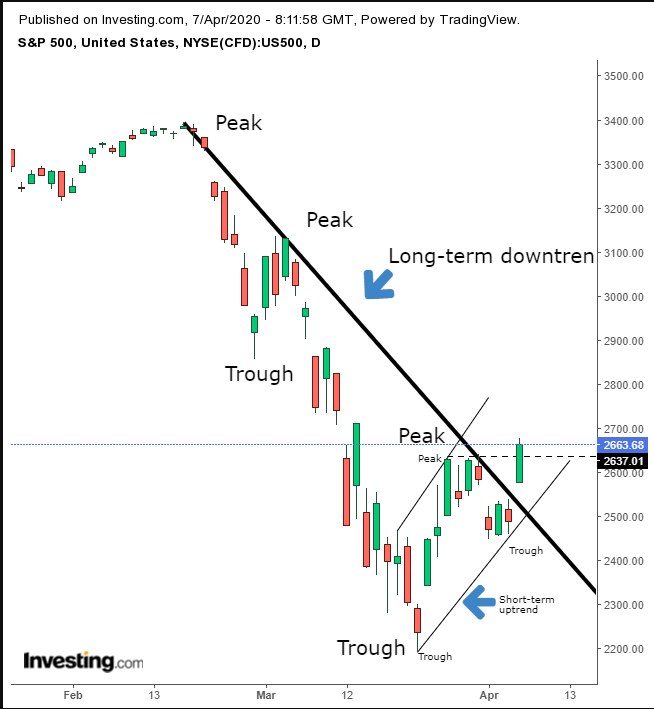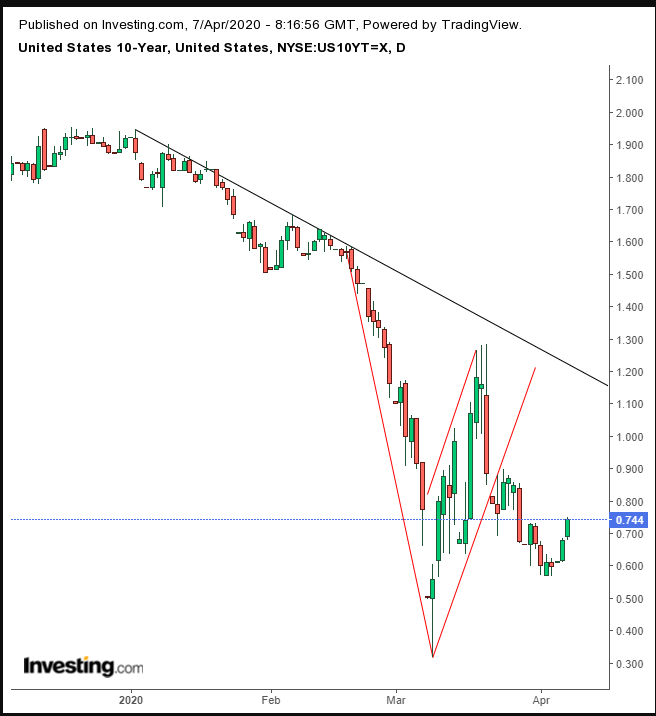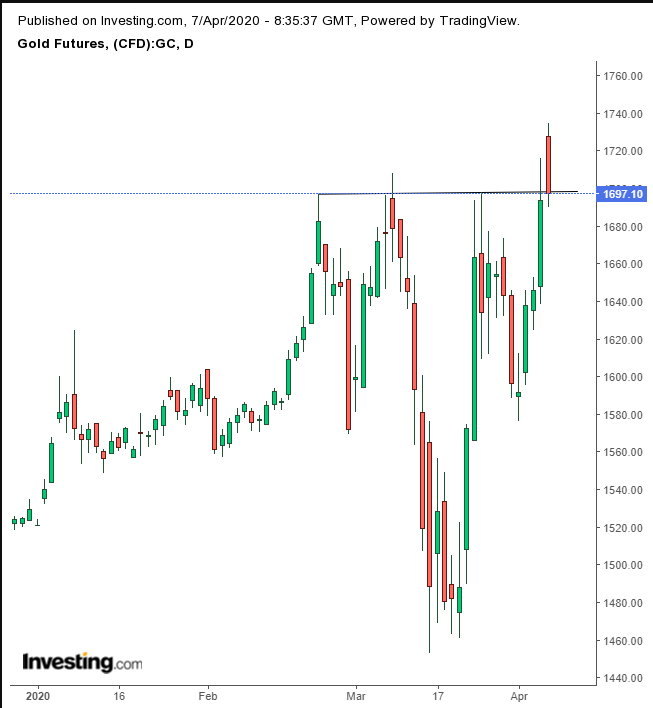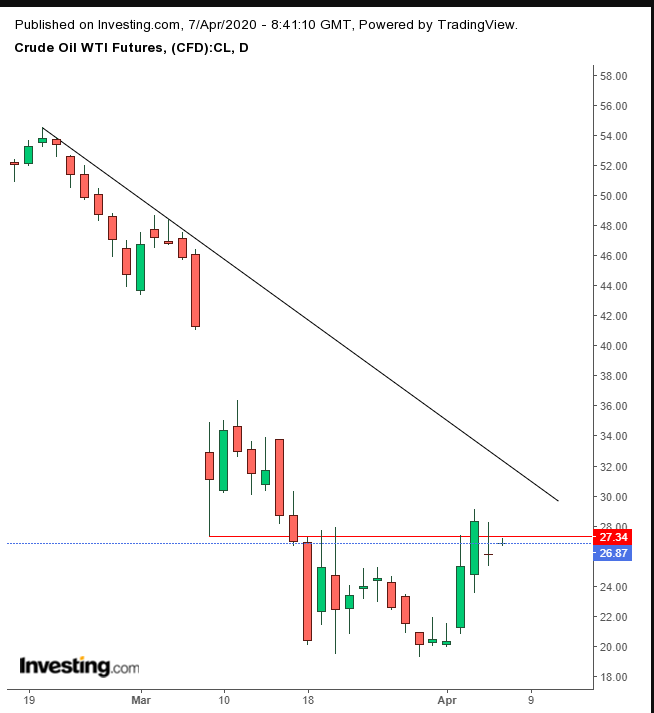- China reports zero COVID-19 related deaths for the first time since January
- Global markets rally continues for a second day
- UK PM Boris Johnson in ICU with worsening coronavirus symptoms, but sterling rises
- S&P 500 completed short-term uptrend on Monday
Key Events
Global stocks and U.S equity futures extended yesterday's gains on Tuesday, fueled by fresh signs that the coronavirus pandemic could be flattening in some global hotspots. As well, risk assets gained additional traction from Wall Street's buoyant Monday session. Nevertheless, the number of U.S. deaths from COVID-19 have now topped 10,000.
Treasurys continued to sell off along with the U.S. dollar.
Global Financial Affairs
Contracts on the four main U.S. indices—the Dow Jones, S&P 500, NASDAQ and Russell 2000—have each climbed more than 3% at time of writing, with futures on the Dow Jones Industrial Average currently nearing the 4% mark. U.S. futures appear to have picked up where their underlying benchmarks left off yesterday. Each of the underlying indices gained more than 7% in New York trade yesterday, besting three-weeks highs.
This morning European shares rose, pushing the pan-continental, Stoxx Europe 600 Index higher for the second day, to a near four-week high.
Most of Asia was also in the green, with Australia’s ASX 200 reversing, (-0.65%), after the country's central bank, released pessimistic commentary in this morning's RBA rate statement on the country’s jobs market outlook. Financial shares led the declines.
China’s Shanghai Composite, (+2.05%), performed similarly to Japan’s Nikkei (+2.01%), both only slightly better than Hong Kong’s Hang Seng (+1.92%) or South Korea’s KOSPI (+1.77%).
Of additional interest, Chinese shares have consistently outperformed even as other regional and global markets were sold off. And this was true even when the country was ground zero, and later the epicenter, of COVID-19 related deaths. After reporting its first day with zero deaths (though many health workers and analysts are dubious), why today is its performance just on par with the rest of the region? Though the reasons aren't yet clear, it could be the mediocre gains are a result of profit-taking, or perhaps a lack of trust in the government data.
Yesterday, Wall Street enjoyed the biggest equity market advance in nearly two weeks. During the final hour of trade, bulls rushed in, propelling the S&P 500 Index higher by 7%; the mega-cap Dow Jones soared 7.73%. The NASDAQ Composite jumped 7.33%. The small cap Russell 2000 outperformed, adding 8.69% of value.

From a technical perspective, the S&P 500 just completed a short-term uptrend within the long-term downtrend.

Yields on the 10-year Treasury extended an advance after completing a rising flag, bearish following the preceding plunge.
The U.S. dollar fell the most since March, ending four days of gains.

Technically, should prices close at these levels, they will have completed an Evening Star, which would retest the bottom of the rising channel.
The pound advanced even as UK Prime Minister Boris Johnson was moved to intensive care as his symptoms of COVID-19 worsened.

From a technical standpoint, cable may be forming a falling flag, bullish after the preceding 8% surge in the four days right before the pause.

Gold futures have completed a H&S continuation pattern. Still, the precious metal is finding it difficult to hold on to gains amid market risk-on. For now, the neckline provides support.

Oil rose on hopes of a resolution to the price war and production tussle wreaking havoc with crude prices. It's hoped that Thursday's scheduled OPEC+ meeting would allow them to reach a deal to cut production and save the market from drowning in unwanted oil. Unfortunately, that may not be soon enough to help out some U.S. shale drillers.
Whatever the outcome, from a technical perspective, the price could not climb above the resistance of the March 9 low.
Up Ahead
- U.S. oil stockpiles are reported on Wednesday and are expected to fall to 10.133M from 13.83M.
- UK GDP and U.S. PPI prints are released Thursday.
- On Friday, U.S. Core CPI is expected to show a decline.
Market Moves
Stocks
- Futures on the S&P 500 Index advanced 2%.
- The Stoxx Europe 600 Index increased 2.8%.
- The MSCI Asia Pacific Index climbed 2.2%.
Currencies
- The Dollar Index declined 0.6%.
- The euro increased 0.7% to $1.0866.
- The British pound gained 0.8% to $1.2324.
- The Japanese yen gained 0.4% to 108.83 per dollar.
Bonds
- The yield on 10-year Treasuries increased six basis points to 0.73%.
- Germany’s 10-year yield climbed four basis points to -0.38%.
- Britain’s 10-year yield jumped four basis points to 0.368%.
Commodities
- West Texas Intermediate crude climbed 3.8% to $27.08 a barrel.
- Gold advanced 0.2% to $1,663.53 an ounce.
